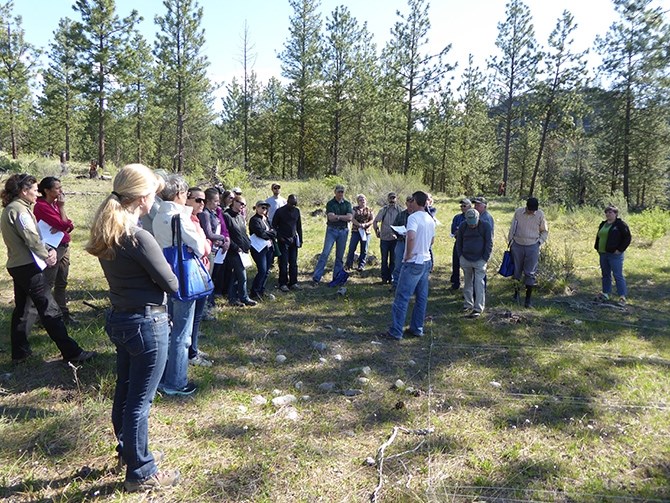
A group of foresters, biologists, conservationists and members of the public took a look at efforts to find a strain of grass that would offer protection against invasive plant species in forested areas above the valley on Wednesday, April 29, 2015.
Image Credit: Lisa Scott
April 30, 2015 - 4:32 PM
PENTICTON - A widely diverse group of biologists, foresters, agrologists, conservationists and members of the general public took to the hills above Okanagan Falls Wednesday to learn more about ways to fight invasive plants.
The 35 member tour, April 29, took a look at seeding experiments conducted by the Okanagan and Similkameen Invasive Species Society, who are studying grass seed mixes. They are trying to determine what grass seed mix provides the quickest way to reduce invasive plants to a point where they no longer threaten the environment.
Grass seeding is a commonly used practice by the forest industry to manage erosion along road right of ways, but little is known about the effectiveness of seeding as a tool to reduce invasive plant outbreaks in forested areas.
"We are testing three different combinations of grass seed at various elevations with different moisture requirements,” Invasive Species Society Coordinator Lisa Scott says. “It’s important to provide seeding options to forestry companies, ranchers and other land managers that take regional variation into consideration."
Her work involved the planting of three different grass blends following initial inventory of invasive plants and the identification of planting locations after conducting tours over 60 forest services roads in the area.
The project, which began in 2011, is part of an initiative funded by the Sustainable Forestry Initiative and the Nature Trust of British Columbia. The focus of the effort is on invasive plants which directly threaten, or are likely to threaten, native plant and animal communities. Weyerhaeuser and Gorman Brothers Lumber manage the lands on which the project is taking place.
Results of the project’s research is expected to be wide ranging. Andrew de Vries, with the Sustainable Forestry Initiative, says he expects the research to apply through the dry interior forests of B.C. and the western U.S. states.
Initial results of the research was showcased during Wednesday’s field session. Scott says results of the seeding program would take several years to fully assess, adding there wasn’t a lot to see just yet. Continued monitoring of the sites will take place over several years, the results to be shared with forestry companies and ranchers.
“Everyone was going to a single mix when reseeding, no matter what the environment or elevation," Scott says. "I wanted to look at variations, to come up with a mix that meets the requirements of a reseeding program in addition to providing protection against invasive species."
The B.C. government estimates over 20-million hectares of Crown land are susceptible to invasion by non-native species. The invasive species threat has been identified as one of the top three most significant threats to biodiversity in the province.
To contact the reporter for this story, email Steve Arstad at sarstad@infonews.ca or call 250-488-3065. To contact the editor, email mjones@infonews.ca or call 250-718-2724.
News from © iNFOnews, 2015